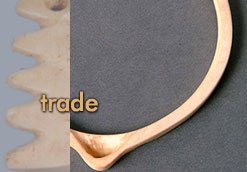
 |
High quality cherts, used for stone tools such as projectile points, knives, and scrapers came from the same nearby areas. These include Brushy Basin chert from the northwestern San Juan Basin, Narbona Pass [formerly Washington Pass] chert from the Chuskas, and Zuni Spotted chert from the Zuni Mountains. Obsidian, a volcanic glass, was also imported. The nearest sources are the Jemez Mountain range to the east of Chaco, and Mt. Taylor to the south. Obsidian was widely used prehistorically because of the extremely sharp edges produced by flaking obsidian nodules into knives and blades. Local trade also allowed people to share information. Reliable, timely information about where there was abundant game, a good piñon nut crop, or where the rains were falling was crucial to people living in a marginal environment like the arid Southwest. The people of Chaco Canyon also traded for non-utilitarian goods, sometimes called 'exotic goods.' Turquoise was brought in and made into ornaments such as pendants and beads, and used as inlay to decorate other objects. The nearest turquoise source is Cerrillos, New Mexico. Turquoise is still highly valued among Southwestern Native American peoples. Workshops were common in Chaco. Some archeologists have speculated that turquoise production helped make Chaco Canyon a ceremonial or religious center. Other goods came from even further away. Long-distance trade brought macaws, shell, and copper into Chaco Canyon. Shells from the Gulfs of Mexico and California, and the Pacific Ocean were made into a variety of ornaments, such as pendants, beads, and bracelets. Macaws were valued for their feathers and were kept in captivity in Pueblo Bonito, a central Chaco Canyon settlement. Long-distance trade routes were well established and long-lived. Puebloan trading expeditions to Sonora and the Gulf of California continued well into the mid-1800s. |
||
|
Today, Chaco Canyon is a resource-poor locale. A thousand years ago, the outlook was not too different. The Chaco Wash ran with water only seasonally. Agriculture was always a risky business on the Colorado Plateau. As a result, the Chacoans engaged in regional and long-distance trade.
Utilitarian goods were imported into Chaco from close by. Ceramic wares came from the San Juan region to the north, the Chuska Mountains to the west, and the Zuni area to the south. Few pots were made in Chaco Canyon, probably because the demand for wood to construct the great houses depleted fuel sources needed to fire ceramics. |